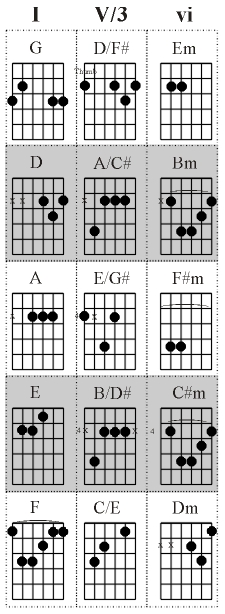Chord Progressions
Simple Bass Line ProgressionsWhat is a Bass Line Progression?
 A bass line progression is a progression where the bass note (the lowest pitched note) of a chord is changing and following a predetermined or predictable pattern. A “bass line progression” is also called a “walking bass line”. There are two generic types of bass line chord progressions: ascending (the bass line goes higher in pitch) and descending (the bass line goes lower in pitch). The bass line progressions can be pictured as going up or down a small set of stairs.
A bass line progression is a progression where the bass note (the lowest pitched note) of a chord is changing and following a predetermined or predictable pattern. A “bass line progression” is also called a “walking bass line”. There are two generic types of bass line chord progressions: ascending (the bass line goes higher in pitch) and descending (the bass line goes lower in pitch). The bass line progressions can be pictured as going up or down a small set of stairs.
Bass Note is Usually the Root
The I - V/3 - vi Progression
A common bass line progression occurs with a I chord (the root chord) and the vi chord (it’s relative minor). For example, the C chord’s relative minor is Am. C is the I chord and Am is the vi chord. But there often is a transition chord played between these two chords: the V chord with its 3rd note in the bass, or V/3. The V chord in the key of C is G major, and G’s 3rd note is B, thus we have G/B. Our progression could look like this: C – G/B – Am

Listen to this progression in C:
This is a descending bass line progression. The bass line follows the notes of the C major scale in descending pitch: C, then B, then A.



This is a great lesson and perfect for me in my Chord studies. The finger picking pattern above sounds beautiful. Am I correct that the pattern is:
e|———-0————————3———————–0————————0—————|
B|——-1—-1——————3—–3—————–1—–1——————1—–1————|
G|—-0———-0—–0—–0———–0—–0—–2———–2——2—–2———–2———|
D|——————————————————————————————————|
A|–3—————3—–2——————2—–0——————0—–0—————–0–3—|
E|——————————————————————————————————|
And repeat? Thanks for posting all this!
Looks great! Thanks for the kind words. The only exception might be the last note I might be playing the 2nd fret on 3rd string… but you may have meant a walk up back to the C with a 2nd fret on the 5th string… But either way sounds good.
Awesome page and info! Thanks for demystifying bass for me!
Nice work
I appreciate the information very much. I received a better understanding in the theory of bass by reading just this article alone.
Thanks Garren. I always appreciate hearing when this information is helpful to people.
Thank you for helping me understanding chord progressions. My eyes were open this morning and for the first time I understand from you explanation…I am grateful.
Thanks again,
Tim
Bass player